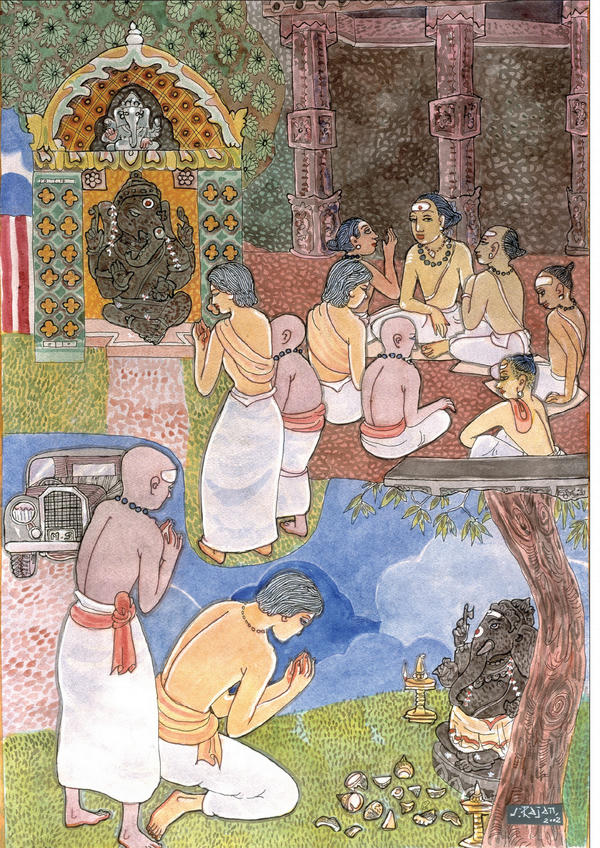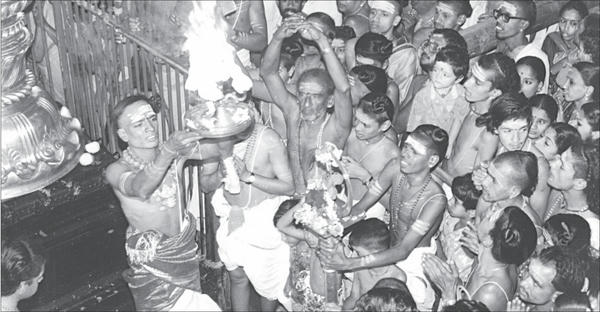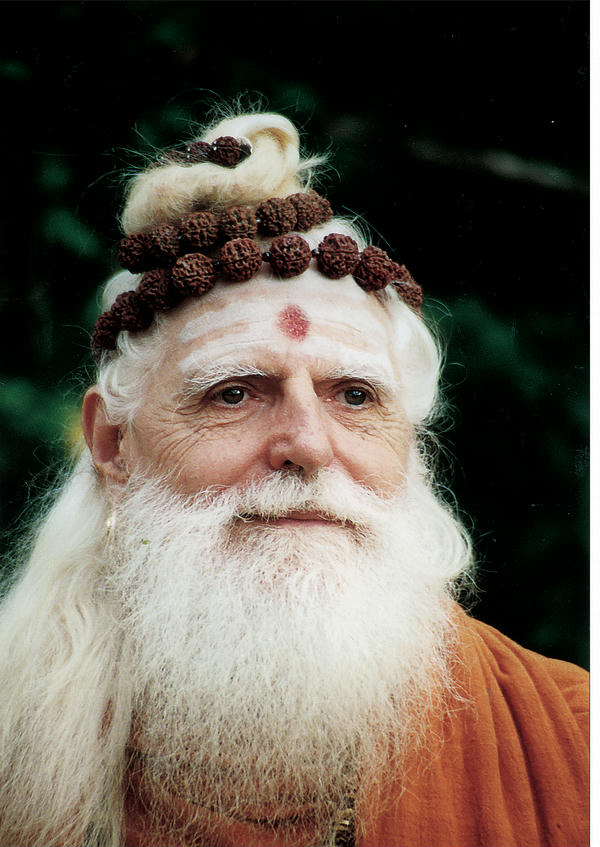Colophon§
Antyavachanam§
अन्त्यवचनम्§
loving Gaṇeśa: Hinduism’s Endearing Elephant-Faced God was designed and illustrated by the swāmīs of the Śaiva Siddhānta Yoga Order at Kauai’s Hindu Monastery on the Garden Island in Hawaii. This third edition of Loving Gaṇeśa was edited using InDesign. Original input and author’s editing were created years ago on an ethernet-based series of Macintosh PowerBooks using Farallon’s Timbuktu in a Winnebago field office.§
The cover art is a watercolor by Tiru S. Rajam of Chennai, India, commissioned for this book in 1997. The Deity paintings on the title page and after the introduction are by the same artist, who was a venerable national treasure of South India, musical composer and traditional Tamil Śaivite artist whose work is permanently exhibited in the British Museum in London. The vivid oil portrait of Gurudeva on the back cover was a gift from India’s renowned artist and national treasure, Sri Indra Sharma, during his sojourn on Kauai in late 1997. He was also commissioned to execute the portrait of Jnanaguru Yogaswami on page 4, a likeness described to be “just like he looked,” according to Srila Sri Sivaratnapuri Tiruchiswamigal of Bangalore, who knew him well. Many of the illustrations are by Tiru M. Arumugam of Chennai, India, commissioned for the second edition in 1999.§
The cover design and Himalayan Academy logo were created by San Francisco artist John Kuzich. Sanskṛit proofreading and guidance for the first edition was studiously provided by: Pandit Satya Pal Sharma, founder of the Vedic University of America in San Diego; Vyaas Houston, founder of the American Sanskṛit Institute; Dr. P. Jayaraman, Executive Director of Bharatīya Vidya Bhavan, Woodside, New York; Pandit and Jyotisha Sastri Laxmishanker Trivedi and his son Devendra of Fremont, California; and Professor Jayaram Sethuraman at Florida State University in Tallahassee. Assistance was also given by Dr. Deendayal Khandelwal of the Hindu University of America in Orlando, Florida, and Sri Sri Bairavasundaram Sivacharya at the New England Hindu Temple. (Comprehensive proofreading was accomplished by Tirumati Sundari Peruman of Houston, Texas; Sri Krishna Mohan of Boise, Idaho; Tirumati Chamundi Sabanathan of Kauai, and the family members of our Śaiva Siddhānta Church Wailua Mission.§
We are most grateful for the extracts from Tattvaloka, a monthly religious journal edited by Sri T.R. Ramachandran and produced under the guidance of H.H. Jagadguru Sankaracharya of Sri Sarada Pitham, Karnataka, India. Sections on Praṇava Aum and the life and teachings of Auvaiyar Ma are from Aum Gaṇeśa, the Peace of God, a work of Ratna Ma Navaratnam, respected educationalist, author and close devotee of my satguru, Asan Yogaswami, whom we worked with in promoting the dharma in Sri Lanka for over 30 years. My dear friend Sadguru Sant Keshavadas kindly contributed “A Special Collection of Gaṇeśa Mantras” from his book Lord Ganesha. Sangaratna Dr. S.M. Ponniah of Malaysia, a renowned Hindu scholar and Śivabhakta, produced the chapter “In Praise of Pillaiyar,” a collection of Tamil devotional poetry translated into English. For all this noble, talented and selfless assistance, we want to offer our heartfelt appreciation. May many blessings come to each one who contributed to this tome.§
Exacting Sanskrit proofreading and guidance for this second, colorful edition was provided by Adaityananda Saraswati (Adam Welch) of Tampa, Florida. And thanks to Exoticindia.com for making available several of the paintings of Indian artist Kailash Raj.§
In defining the practical and esoteric aspects of Hindu liturgy, as reflected here in the chapter “Home Liturgy,” we were blessed with the insights of Sri Sambamurthi Sivacharya of the South India Archaka Sangam, who in the mid-’80s sent to Hawaii two expert priests, Kumaraswami Gurukal and Shanmuga Gurukal, to train my Śaiva swāmīs in the performance of Śaiva pūjā.§
Calling forth the blessings of inner worlds, Dr. A. Anandanataraja Dikshitar and others of the ancient hereditary Dikshitar priesthood at Chidambaram Temple in South India (see photo on the following page) performed monthly pūjās blessing this work for many years. At Kauai Aadheenam’s Kadavul Hindu Temple on the island of Kauai in the Hawaiian Islands, the world’s most remote land mass, during the two years it took to create this edition my monks, maṭhavāsis, held (and continue to hold) successive three-hour vigils around the clock and performed pūjā every three hours, night and day, without fail.§
Going back even further in our history, deep thanks and appreciation go out to a wonderful soul, Kandiah Chettiar, who assisted in introducing me to the culture and holy people of Jaffna, Sri Lanka, and especially for taking me to meet my satguru, the venerable Sage Yogaswami. Indeed, Lord Gaṇeśa was there to bless our journey. On the way from Colombo to Jaffna, Chettiar, my guide and mentor appointed by Yogaswami stopped the car at the small roadside shrine in Murukandi. He explained that travelers who did not halt to worship here were not admitted safe passage to the psychically protected area of the carefully guarded northern Śaiva peninsula.§
We got out of the car just as night was falling. We could hardly see the Deity but for the flames of camphor that the many pilgrims were burning. In the twilight could be heard the loud crack of coconuts being broken for safe passage. I remember standing transfixed near that little Pillaiyar shrine, not far from our car. My sahasrāra chakra began to spin powerfully, and I inwardly observed a flame at the top of my head about three or four inches in height. It remained with me for a week or more. At that moment, I knew Gaṇeśa’s grace and blessings for my travels now and in the future would always be with me. I was twenty-two at the time. Five decades later this has proven to be true. Little did we know, in that summer twilight in 1949, what doors that wise, elephant-faced Deity would open to us in the years ahead.§
We conclude Loving Gaṇeśa with abundant thanks to all His devotees who participated so willingly in writing this biography of a universal God. All who enter the path to Self Realization do so through His grace and His alone. This has proven to be true through the many years of my life.§
Art at left: Artist S. Rajam depicts two encounters the young Gurudeva had with Lord Ganesha in Sri Lanka in 1949. Above, the American seeker worships in a small temple in Colombo, where he met Kandiah Chettiar. A council of elders met to allow the American devotee to come often to the temple. The lower panel illustrates the moment at Elephant Pass when Lord Ganesha greeted Gurudeva, welcoming him to enter the Jaffna Peninsula for the first time.§



